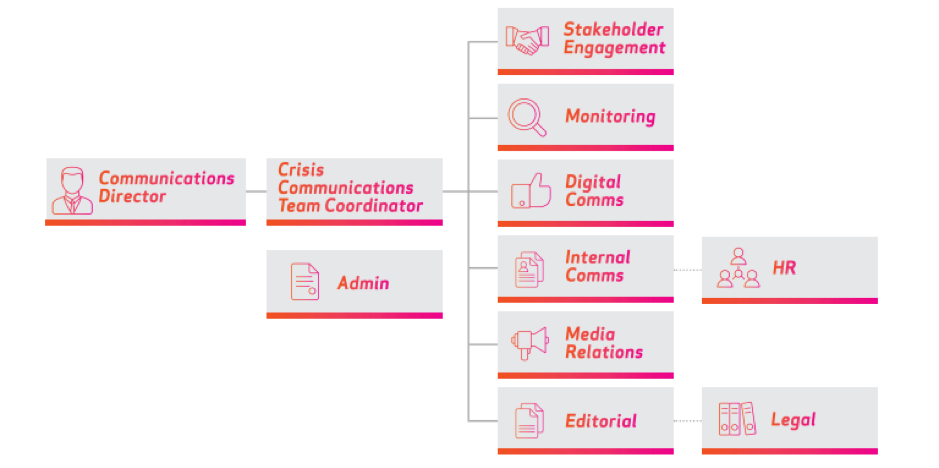If a crisis situation occurs, it’s important to know how to respond from a communications and operational standpoint, in order to maintain your reputation and avoid any long-term damage to the brand.
The way that businesses respond to a crisis often defines how they come out the other side.
How to develop a crisis manual
Step 1: Establish the potential risks
Thinking about what the ‘worst-case scenario’ might look like across different lines of the business is a good place to start – and this requires some creative thinking. It might be that a line of your product gets contaminated sparking a campaign to boycott your brand, or that you experience a large-scale data breach that exposes sensitive customer data. There’s a whole array of potential circumstances that will be specific to you and your business, but if you can realise those risks, you give yourself a better chance of a) mitigating the risks so there is less chance of the event happening and b) responding in an appropriate way, quickly.
It’s important to capture all the potential types of crises so that you are prepared for anything and everything. Each department will have their own crisis scenarios keeping them up at night, and it’s crucial to speak to each area of the business, establish their risks and ensure all eventualities are accounted for.
Once you have explored all the different crisis scenarios, you’ll need to create a severity criteria. A traffic light system works well here. For example, a number of customer complaints picked up by the media might be defined as low level risk, but has the potential to escalate into a full-blown crisis if a campaign to boycott your brand is launched. Whereas an explosion in your office will be defined as red, as it would have a devastating impact on both internal and external stakeholders and potentially impact the business’ ability to operate.
Green (may affect reputation but does not require an urgent business-wide response)
Examples: negative conversation online, minor customer complaints
Amber (a serious incident or issue with reputational implications, but specific to one site or part of the business)
Examples: widespread customer complaints, social media-based campaign
Red (a critical situation or major emergency threatening reputation and its ability to operate as a business)
Examples: large scale data breach resulting in loss of customer data, major fire or natural disaster, terrorist attack, board-level scandal
Step 2: Clarify your incident escalation process
Once you know what your red, amber and green-level crises are, the next stage is to create an escalation process. One way to do this is to make a visual flow chart, showing from the outset of the incident who you need to inform and what needs to be asked. Having a clear, easy to follow escalation process will enable anyone, familiar with the crisis manual or not, to follow a company-wide agreed procedure to collate information, inform the right people and respond in a unified manner.
An example of a crisis comms team, taken from the TEAM LEWIS guide to Crisis Communications
Considering different scenarios to create a template escalation process will arm you with the agreed protocol when a crisis occurs. It will also help you consider tasks like preparing a media statement, managing internal comms and when to engage with your stakeholders.
Next if relevant, notify your comms agency (or agencies). In the early stages of an issue or crisis, your agency will be able to monitor conversation online – both in the media and on social channels – to help create a clear understanding of scale as well as key influences that are joining in, or possibly driving, the conversation. During the crisis, your agency can be called upon to help create comms material, messaging, Q&As and media statements. Post crisis, they can help understand the reach and potential impact of the event. It may be that they create a post-crisis report or action plan to help fully understand why the event occurred, what you can do to mitigate chances of it happening again, and identify key influencers, stakeholders and journalists, in a bid to build the company’s reputation once again.
Step 3: Create a simple, easy to read document outlining the process
When a crisis hits, there isn’t always time to think. Having everything in place beforehand, will undoubtedly put you in good stead when it comes to following an agreed procedure. As a result, crisis manuals need to be easy to follow and easy to read. There is nothing worse than having a 100-page document that has old contacts, unclear procedures and a lot of fluffy business jargon.
There is no one-size fits all when writing a crisis manual. However, there are some top tips, that can be applied to all plans. This will ensure you not only move quickly, but also don’t miss anything out.
Top tips:
- Include a contents page – Crises are fast moving, help yourself by making it easy to find what you or anyone else might be looking for, quickly
- Keep it short and sweet – A crisis manual is no place for ‘fluff’ or long, complicated sentences. Make it short and snappy, easy to read and follow
- Have a crisis tick list – There is no harm having a generic check list at the back of your manual. This could include things like, inform legal, or monitor activity on social media platforms, or prepare reactive media statement and relevant Q&As
- Have a template meeting agenda – When a crisis team meeting is called, this should include: attendees and their roles in the crisis, what information you know, what your reputational objective is, whether you are going ‘above and beyond’ in your response, what actions and priorities each member is going away with, and an agreement of your next team meeting
- Include contact details – Speed is of the essence. As such, having key contacts with 24/7 numbers and email addresses will enable you to move with speed and ease
- Consider including third party stakeholders – While this varies hugely depending on the nature of your business, this could be local police contacts, the ICO in case of a data breach
- Always ask, are we doing all that we possibly can – Going above and beyond during and after a crisis can ensure that you come out the other end, maintaining your reputation.
Looking for a helping hand with your crisis communications? TEAM LEWIS can support you in creating a crisis manual to ensure your business is fully prepared for all odds, provide training to executives who will be the face of the company in such times, and we will see you through the grey clouds when they do occur. Feel free to contact us for a chat.



